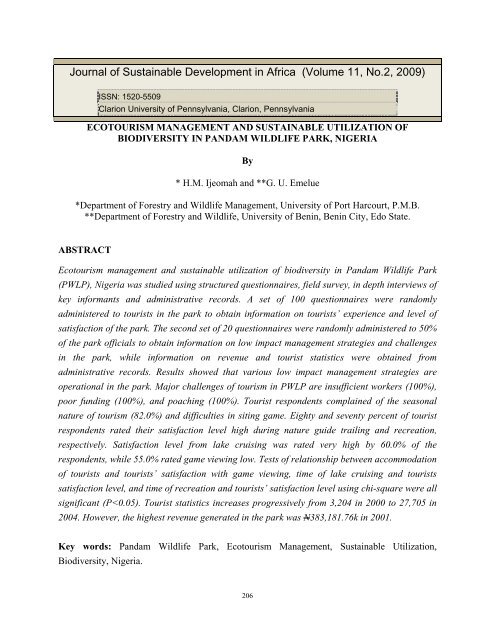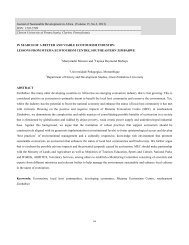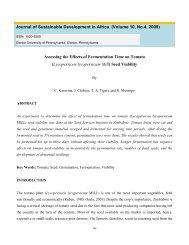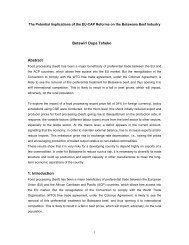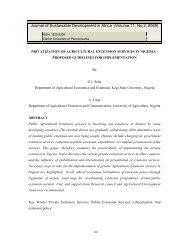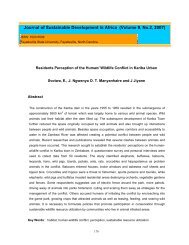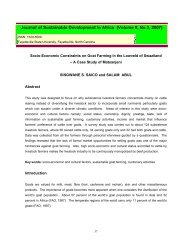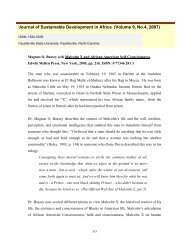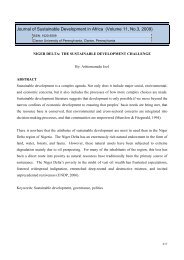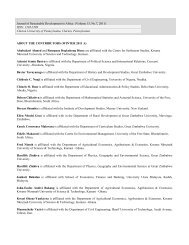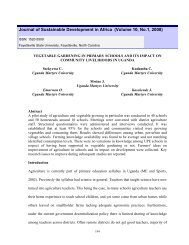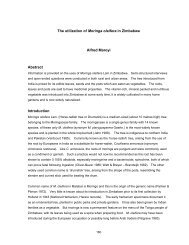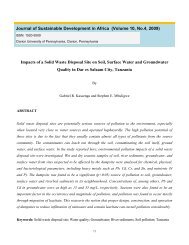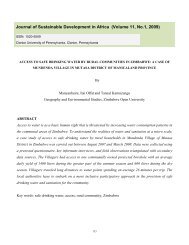ECOTOURISM MANAGEMENT AND SUSTAINABLE UTILIZATION ...
ECOTOURISM MANAGEMENT AND SUSTAINABLE UTILIZATION ...
ECOTOURISM MANAGEMENT AND SUSTAINABLE UTILIZATION ...
Create successful ePaper yourself
Turn your PDF publications into a flip-book with our unique Google optimized e-Paper software.
Journal of Sustainable Development in Africa (Volume 11, No.2, 2009)<br />
ISSN: 1520-5509<br />
Clarion University of Pennsylvania, Clarion, Pennsylvania<br />
<strong>ECOTOURISM</strong> <strong>MANAGEMENT</strong> <strong>AND</strong> <strong>SUSTAINABLE</strong> <strong>UTILIZATION</strong> OF<br />
BIODIVERSITY IN P<strong>AND</strong>AM WILDLIFE PARK, NIGERIA<br />
By<br />
* H.M. Ijeomah and **G. U. Emelue<br />
*Department of Forestry and Wildlife Management, University of Port Harcourt, P.M.B.<br />
**Department of Forestry and Wildlife, University of Benin, Benin City, Edo State.<br />
ABSTRACT<br />
Ecotourism management and sustainable utilization of biodiversity in Pandam Wildlife Park<br />
(PWLP), Nigeria was studied using structured questionnaires, field survey, in depth interviews of<br />
key informants and administrative records. A set of 100 questionnaires were randomly<br />
administered to tourists in the park to obtain information on tourists’ experience and level of<br />
satisfaction of the park. The second set of 20 questionnaires were randomly administered to 50%<br />
of the park officials to obtain information on low impact management strategies and challenges<br />
in the park, while information on revenue and tourist statistics were obtained from<br />
administrative records. Results showed that various low impact management strategies are<br />
operational in the park. Major challenges of tourism in PWLP are insufficient workers (100%),<br />
poor funding (100%), and poaching (100%). Tourist respondents complained of the seasonal<br />
nature of tourism (82.0%) and difficulties in siting game. Eighty and seventy percent of tourist<br />
respondents rated their satisfaction level high during nature guide trailing and recreation,<br />
respectively. Satisfaction level from lake cruising was rated very high by 60.0% of the<br />
respondents, while 55.0% rated game viewing low. Tests of relationship between accommodation<br />
of tourists and tourists’ satisfaction with game viewing, time of lake cruising and tourists<br />
satisfaction level, and time of recreation and tourists’ satisfaction level using chi-square were all<br />
significant (P
INTRODUCTION<br />
Overview of the Non-sustainable Utilization of Resources in Nigeria<br />
One of the most serious global challenges to the present generation is how to sustain utilization<br />
of limited natural resources in the face of ever increasing human population. This is worse for<br />
countries like Nigeria with high rates of poverty, where the governments are nonresponsive to<br />
the needs of the people, and the majority of the people heavily rely on natural resources, such as<br />
forests, land, and water for survival.<br />
Evidences of non-sustainable management of resources are numerous in Nigeria. Wase Wildlife<br />
Park has been destroyed (Ijeomah et. al., 2005a). Lake Chad basin has decreased from<br />
25,000km 2 to 2500km 2 between 1960 and 2000 (Jauro, 1998). One third of the Pai River Game<br />
Reserve of Plateau State has been de-reserved for farming, with the remaining two third<br />
neglected (Ijeomah, 2007). The Mado Tourist Village has been abandoned due to<br />
mismanagement. The Yankari Wildlife Park, which was opened to the public in 1962 and<br />
upgraded to a national park in 1991, has been degraded to a game reserve on June 1 st , 2006<br />
(Iduh, 2007; Ogogo, 2008) in pursuit of good management for sustainability. The Nasarawa<br />
Game Reserve proposed as far back as 1971 in Nasarawa State (the then Plateau State) is yet to<br />
be established. The Calabar Zoo has stopped functioning and all the animals therein were<br />
distributed to other zoos. Natural endowments of Nigeria, such as the African elephant<br />
(Loxodonta africana) in Kainji Lake and Cross River national parks, have permanently<br />
emigrated to Niger Republic and the Republic of Cameroon, respectively (Ijeomah and Aiyeloja,<br />
2008). Most fruit trees in the eastern part of Nigeria, particularly oil bean (Pentaclethra<br />
macrophylla), breadfruit (Treculia africana), and Star apple (Chrysophyllum albida) are<br />
endangered because of use pressure, building of houses, and road construction without serious<br />
plans for regeneration (Ijeomah and Ogara, 2006).<br />
The periods of fallow for lands in most rural areas in Nigeria (particularly eastern Nigeria) have<br />
been reduced from about ten to three or two years. Consequently, most wildlife species have lost<br />
their habitats. Even sacred forests that formerly served as the last wildlife refuge are presently<br />
being cleared, either for agriculture or religious reasons (The Nation, 2009). The Akpam sacred<br />
forest of Dikenafai, Imo State was cleared by a chief priest for farming (Ijeomah et al, 2007),<br />
207
while parts of the Urashi sacred forest has been cleared for religious reasons. Many forests in<br />
Benue State are annually burnt by the Tivs while hunting for rat, which is their cultural delicacy.<br />
The country has lost many known and some unknown and unnamed endemic species through<br />
these means (NEST, 1991), whereas every species has a special role it plays in ecosystem<br />
sustainability. Loss of one species could lead to chains of extinction. Raven (1976) reported that<br />
the extinction of each tropical plant species leads potentially to the loss of another 10-30 insect<br />
species. These insects and other species play important roles in plant pollination and seed<br />
dispersal. In the lvory coast alone, elephant (Loxodonta africana) disperses the seeds of 37 tree<br />
species with only seven of these trees having backup carriers. In parts of the lvory coast, where<br />
elephant has become locally extinct, none of the thirty tree species (except the old ones) where<br />
found, although many animals depend on them (Tangeley and Miller, 1991; Ijeomah et al.,<br />
2005b). Tangeley and Miller (1991) emphasized that seven common squirrels in the country feed<br />
specifically on one of these trees. ‘Take the lemurs out of Madagascar and 20 different trees in<br />
the forest could disappear because their seeds are no longer dispersed. In parts of India, tigers are<br />
suffering from lack of prey, which is being killed by human’ (Carey, 1999). Cultural means of<br />
conservation is failing in many areas due to pressure and change of attitude. Consistent increase<br />
in the cost of kerosene (the cheapest cooking fuel from Petroleum) is forcing the masses to<br />
change to fuel wood. Hence, the rate of deforestation is fast increasing (Faleyimu et al., 2008) as<br />
there is no affordable alternative fuel for cooking (NEST, 1991). High rate of logging without<br />
commensurate artificial regeneration has drastically reduced the number of merchantable trees in<br />
the forest; timber contractors are afraid of loosing their livelihood. In the northern part of<br />
Nigeria, desert encroachment posses its own challenges. Human beings have dominated the<br />
physical structures in Lagos, Abuja, and Port Harcourt, taking over spaces formerly occupied by<br />
fauna and flora.<br />
In the riverine areas, particularly the Niger Delta, pollution of rivers with chemicals from<br />
petroleum industries and refineries have killed and castrated many fish species, and have<br />
denatured the soil by altering its chemical composition (Ibaba, 2002). Succession is taking place.<br />
Water hyacinths are reducing water surfaces (NEST, 1991). Fishermen are rendered jobless;<br />
pollution on land has killed vegetation, which serves as cover for wild animals. Crops have<br />
become stunted in Ogoni, Rivers State. Illumination through gas flaring has caused animals to<br />
emigrate. Farmers have become jobless and are turning to militants. Poverty is fast spreading in<br />
208
the cities and poor urban youths are migrating to their respective indigenous rural communities<br />
for militancy, which they considered lucrative due to corruption. Every species is affected<br />
because of the tension on ecosystems.<br />
All protected areas in Nigeria are economically dependent on either the federal or state<br />
government. Failure of the government to release fund leads to stagnation of conservation<br />
activities. Since money is released on the basis of government interest and policy, most game<br />
reserves in Nigeria exist only on pages of Newspapers without effective form of management<br />
and protection for ecosystems therein. Many hectares of the Stubb Creek Reserve in Akwa Ibom<br />
State have been ceded to different institutions, and petroleum firms are presently drilling oil in<br />
the reserve. There is no substantive forest remaining in Akwa Ibom State. The rate of poaching is<br />
continually increasing and even becoming more organized. This organized poaching is not for<br />
consumption alone but for commercial purposes. The forests are becoming empty of animals<br />
(Redford, 1992; Carey, 1999; Carey, undated). If the 230 inhabitants of three Waorani villages in<br />
Ecuador could kill 3,165 individuals of wild animals at subsistence level in less than a year (Yost<br />
and Kelly, 1983), and 2,847,000 rural Brazilians (FIGBU, 1982) could kill an estimate of 38<br />
million individuals of animals with about 36 million fatally wounded (at subsistence level) in a<br />
year, it then predicts that the number of animals killed by about 60 million rural Nigerians in a<br />
year will be staggering.<br />
In an attempt to check poaching and placate the host communities, participatory management<br />
approach was introduced in protected areas with the aim of involving host communities at<br />
different levels. Many authors have applauded the Cross River forestry commission for the<br />
success of community forestry in the state (at least for the flora) - the presence of soaring,<br />
buttressed tropical trees, does not guarantee the presence of resident fauna; many times trees<br />
remain in a forest that human activities have emptied of many of its large animals (Redford,<br />
1992). Similar arrangement of community forestry exists at the Bimbia Bonadikombo<br />
community ecotourism forest of Cameroon; however, the community guards in the forest are so<br />
aggressive and tend to exploit visitors (Ijeomah et al., 2005b) through their economic demands.<br />
This shows that they are not satisfied with the proceeds obtained from the arrangement, and may<br />
embark on certain unethical practices for economic reasons when the opportunity arises.<br />
209
It was on this basis that Carey (undated) faulted the concept of local community participation in<br />
conservation area management, maintaining the opinion that sustainable hunting does not exist<br />
anywhere among indigenous people except where human population is still relatively low,<br />
animal numbers are high, and non indigenous biologists are available to provide long term<br />
guidance. The solution to problems of sustainability is effective human population control, which<br />
is difficult to achieve in rural areas.<br />
Ecotourism was introduced in protected areas as a means of solving financial challenges. But<br />
management of conservation areas would have been easier without the presence of tourists<br />
because of negative impacts. The study, therefore, surveys the low impact management strategies<br />
embarked upon by the management of Pandam Wildlife Park since inception in 1972, and the<br />
implication of these strategies on ecotourism development.<br />
MEHODOLOGY<br />
Pandam Wildlife Park is located North of Benue River (Ezealor, 2002) and South of<br />
Plateau State (Akosim, 1997) along Lafia–Shendam Road in Quaanpan Local Government Area<br />
of Plateau State (Ijeomah, 2007). It lies between latitudes 8 o 35 1 N and 8 o 55 1 N, and longitudes 8<br />
o 00 1 E and 8 o 45 1 E, as shown on Figure 1. The park covers an area of 224 square kilometers.<br />
Data for the study were collected with the aid of structured questionnaires, field surveys,<br />
personal interviews, and administrative records. A set of 100 questionnaires were randomly<br />
administered to tourists in the park to obtain information on tourists’ experience and level of<br />
satisfaction in the park. Another set of 20 questionnaires were randomly administered to 50<br />
percent of the park officials to obtain information on low impact management strategies and<br />
challenges in the park. Information on revenue and tourist statistics was obtained from<br />
administrative records.<br />
210
Figure 1: Map of Plateau State Showing the Location of Pandam Wildlife Park<br />
RESULTS<br />
Low Impact Tourism<br />
Table 1 shows that all staff respondents indicated compulsory use of tour guides, noncreation<br />
of awareness for visitors, closed and open seasons for fishing, closed and open seasons<br />
for tourism, accommodation of few visitors in the lodges, non-commercialization of playing<br />
ground, daily patrolling of park by game guards, creation of out–stations, and community<br />
involvement in anti-poaching exercises as management strategies for low impact tourism in<br />
Pandam Wildlife Park. Table 2 presents the major challenges of tourism in Pandam Wildlife<br />
Park as insufficient workers (100%), poor funding (100%), and poaching (100%). Figure 1<br />
211
shows a pictorial evidence of poaching in Pandam Wildlife Park - poachers’ harvest with small<br />
meshed (unauthorized) fishing net.<br />
Table 1: Management Strategies for Low Impact Tourism in Pandam Wildlife Park<br />
Strategies<br />
Percentage Values<br />
Compulsory use of tour guides 100<br />
Non creation of awareness 100<br />
Off and on season period for fishing 100<br />
Off and on season for tourism 100<br />
Accommodation of few visitors in lodges 100<br />
Non commercialization of playing ground 100<br />
Daily patrolling of park by game guards 100<br />
Creation of five out stations 100<br />
Community involvement in anti poaching 100<br />
exercise<br />
Table 2: Environmental Challenges of Tourism in Pandam Wildlife Park<br />
Challenges<br />
Percentage values<br />
Insufficient workers 100<br />
Poor funding 100<br />
Poaching 100<br />
Insincerity of workers 20.0<br />
Pressure to de-reserve part of the park 50.0<br />
212
213
Figure 1: Poachers’ Harvest with the Use of Small Sized Net<br />
Assessment of Tourist Experience and Level of Satisfaction<br />
Table 3 shows that the satisfaction level of 80.0% and 70.0% of respondents were high<br />
during nature guide trailing and recreation, respectively. Satisfaction level from lake cruising<br />
was rated very high by 60.0% of the respondents, while 55.0% of the respondents rated game<br />
reviewing low. Respondents’ comments on site management are presented in Table 4. Tourist<br />
respondents complained about the seasonal nature of tourism (82.0%) and the difficulties in<br />
siting animals (73.0%). Tables 5, 6, and 7 show that tests of relationship between<br />
accommodation of tourists and tourists satisfaction with game viewing (X 2 = 113.586); time of<br />
lake cruising and tourists satisfaction level (X 2 = 73.237); and time of recreation and tourist<br />
satisfaction level (X 2 =198.00) using Chi-square were all significant (P< 0.05).<br />
Table 3: Assessment of Tourists Experience and Level of Satisfaction<br />
Activities<br />
Level of Satisfaction<br />
Low High Very high<br />
Lake Cruising 27.0 3.0 60.0<br />
Game viewing 55.0 15.0 30.0<br />
Recreation 10.0 70.0 20.0<br />
Nature guide trailing 15.0 80.0 5.0<br />
Sport fishing 0 0 0<br />
Table 4: Complaints by Tourists about Site Management<br />
Complaints<br />
Percentage<br />
Inability to site animals 73.0<br />
Insufficient canoe for lake cruising 64.0<br />
Seasonal nature of tourism 82.0<br />
214
Table 5: Relationship between Accommodation of Tourists and Tourists’ Satisfaction with<br />
Game-viewing<br />
Accommodation<br />
Lodges Pandam Village No accommodation<br />
Low 0 0 55<br />
Satisfaction With High 7 8 0<br />
game Viewing Very high 25 4 1<br />
Significant relationship exist (P < 0.05): X 2 = 113.586<br />
Table 6: Relationship between Time of Lake Cruising and Tourist Satisfaction Level<br />
Satisfaction Level<br />
Time Low High Very high<br />
Morning (7 – 11am) 28 0 0<br />
Afternoon (11.01 – 0 2 9<br />
4.00pm)<br />
Evening (4.01 – 6.00pm) 7 1 1<br />
Significant relationship exist (P< 0.05): X 2 =73.237<br />
Table 7: Relationship between Time of Recreation and Tourist Satisfaction Level<br />
Satisfaction Level<br />
Time Low High Very High<br />
Morning 8 0 0<br />
Afternoon 0 70 20<br />
Evening 1 0 0<br />
Significant relationship exist (P< 0.05): X 2 = 198.00<br />
Tourist Statistics and Revenue Generation<br />
Table 8 reveals that tourist influx increases progressively from 3,204 in the year 2000 to 27,905<br />
in the year 2004. However the highest revenue generated in the park was N383, 181.76k in 2001<br />
while 2003 recorded the least revenue of N183, 631.17k as show in table 9.<br />
215
Table 8: Tourist Visitation to Pandam Wildlife Park<br />
YEAR/MONTH 2000 2001 2002 2003 2004<br />
January 200 485 851 265 2,961<br />
February 176 500 782 435 1,442<br />
March 125 559 874 435 1,442<br />
April 445 299 355 3,190 4,753<br />
May 445 299 355 2,153 2,053<br />
June 80 437 593 1,643 1,573<br />
July 38 23 425 1,344 2,207<br />
August 43 545 474 974 1,299<br />
September 56 17 915 594 1,223<br />
October 55 21 2,058 610 1,295<br />
November 41 836 2,050 705 1,295<br />
December 1,821 3,262 1,204 1,784 3,006<br />
Total 3,204 7,416 10,986 15,788 27,905<br />
Grand Total: 65,299 Tourists<br />
Table 9: Summary of Revenue Generation from Pandam Wildlife Park between 2000 and<br />
2004<br />
Months 2000 2001 2002 2003 2004<br />
January 31370.00 36,789.00 40388.68 42640.00 60,487.32<br />
February 34465 32,748.00 45,365.00 27500.00 56,579.88<br />
March 45750 35,595.00 58,329.00 25052.66 45,438.00<br />
April 42540 45,036.00 50,999.00 44,678.55 24,617.00<br />
May 54405 64,898.00 29,911.00 43,796.92 19,341.00<br />
June 19325 19,262.84 7687.00 17,121.32 17,316.00<br />
July 21520 8,828.80 4956.00 9,492.90 10,483.00<br />
August 13755 7616 8671.00 12054.00 12,215.00<br />
September 13795 6081.04 3541.00 10,665.00 12,975.00<br />
October 12,680 9,625.00 15,250 16,000 17,235.00<br />
November 29069 64,125.00 36,166.55 14,484.82 31,305.00<br />
December 27215 52,577 36850.00 20,127.00 65,640.00<br />
Total 345,889 383,181.76 287,115.23 283,631.17 373,632.2<br />
DISCUSSION<br />
216
Sustainable Tourism Management Strategies and Challenges<br />
Since the Park was not previously collecting gate fee (this was not done until 2005), it would<br />
have been easy for a visitor to enter the park without being guided. The management of the park,<br />
however, monitors the movement of visitors to avoid anti-conservation practices. Awareness for<br />
tourist visitation is not being created by the park management, though visitors are cordially<br />
welcomed. This is to avoid overcrowding of tourists which might negatively impact the ecodestination.<br />
Ijeomah et al. (2005c) reported that on an annual basis, the Jos Wildlife Park is<br />
always overcrowded with tourists, and polluted with dust, which impairs respiration and<br />
visibility during festive periods, particularly between December 24 th and January 1 st . Occurrence<br />
of such levels of environmental pollution in the Pandam Wildlife Park could lead to death of<br />
both human and wild animals. This is because Pandam is a relatively hot region (being low land),<br />
unlike Jos that is always cold due to its high lands (PSTC, 2005; Ijemoah, et al., 2005b).<br />
‘Open and close’ seasons for fishing are observed in Pandam Wildlife Park to check cases of<br />
over-fishing in the Pandam Lake. Maximum of 20 visitors could be accommodated in the lodges<br />
at a time to ensure unique experience and prevent overcrowding. This is contrary to the report of<br />
Kamuaro (1996). The playing ground at the centre of the park is not commercialized, unlike the<br />
pine forest of the Jos Wildlife Park that is rented out for social functions on a regular basis. To<br />
ensure easy monitoring of the park, five security out-stations were created in communities<br />
bordering the park. Game guards are stationed in these outstations on a daily basis. The people of<br />
Kayarda community are incorporated into the anti-poaching programme of the park. They can<br />
arrest poachers and contact the park management for prosecution.<br />
Understaffing and inadequate funding are challenges to the provision of adequate protection for<br />
the resources in the face of poaching and consistent pressure from neighboring communities to<br />
de-reserve part of the park. Similar cases of inadequate protection from poaching due to<br />
understaffing, and demand for de-reservation of part of conservation areas, exists in both Old<br />
Oyo and Cross River national parks. It is only in Buya section (part of the core area) of the Old<br />
Oyo national park that animals are adequately protected. The demarcating water bodies in Buya<br />
section make it difficult for them to poach animals due to the fear of being caught. Also, in the<br />
217
Kainji Lake national park, poachers hardly cross the Oli River to poach for animals. However,<br />
Kainji Lake national park has lost its buffer zones to farmers.<br />
Occasionally, some workers do connive with poachers to exploit resources in a non-sustainable<br />
manner. Figure 1 shows a picture of different species of fish caught in the Pandam Lake with<br />
small meshed net – an evidence of destructive harvesting.<br />
Tourists’ Experience<br />
Tourists cherish lake-cruising in the Pandam Lake, recreating in the cool natural<br />
environment, and trailing the nature guide (Table 3). Experience in game viewing was rated low<br />
by many tourists (Table 3). In in situ management of species, games can hardly be sited without<br />
prior knowledge of the behaviour of the species. This is contrary to what obtains in captive<br />
management of species. The satisfaction level of game viewing is low for tourists that are nonresidents<br />
(in the lodge or Pandam village). Animals in the park, particularly baboons, move in<br />
hundreds between about 6:30 and 7:30 in the morning and evening on a daily basis. They are the<br />
most conspicuous species in the park and move in a company of monkeys within this time<br />
interval, as reported by Ijeomah and Ogogo (in press). During these periods, the primate species<br />
cover the entrance of the Park, the Park administrative building, and even the lodges. In the<br />
afternoon, they return to their hiding places. Ijeomah and Ogogo (in press) reported that this<br />
pattern of operation has been consistent for many years. Tourists that visit only in the afternoon<br />
will miss this beautiful site. Nevertheless, one of the biggest games in the Park, the<br />
Hippopotamus amphibious, can hardly be sited by tourists, as they operate in the night.<br />
Tourists’ experience of lake cruising is rated high between 11:00 a.m. and 4:00 a.m.<br />
when the weather is not cold. Similarly, recreation in the park is more cherished when the<br />
weather is hot. The boat for lake cruising is hardly available nor in a good condition to be used<br />
by tourists. Often times the boat operators are unavailable. Similar observation was made in Oli<br />
River of the Kainji Lake national park.<br />
Tourist Influx and Revenue Generation<br />
The lack of awareness for visitors in the Park has affected both tourism growth and revenue<br />
generation (from tourism) in the park. The cumulative number of tourists in the park between the<br />
years 2000 and 2004 was 64.699, whereas Ijeomah (2007) documented that Jos Wildlife Park (an<br />
218
eco-destination) in the same Plateau State had 65,828 tourists in 2000 alone. The park<br />
management does not create awareness for tourist visitation yet the few visitors that patronize the<br />
park are not made to pay an amount that would help the management to cover costs, unlike in<br />
Lake Nakuru National Park of Kenya (Bolton, 1997), Galapagos Island (Tangeley and Miller,<br />
1991) and the recommendations of Goosling (1999). Revenues generated between June and<br />
October were relatively lower than that generated in other months. Between June and October<br />
are closed seasons for fishing in the Pandam Lake. The non-correspondent increase between<br />
tourists’ influx and revenue generation is because the park does not rely on revenues generated<br />
through gate takings. Similarly, tourists who visited Wase Wildlife Park (before its closure) and<br />
Assop Falls Resort did not pay gate fees.<br />
CONCLUSION<br />
Pandam Wildlife Park is a conservation area that has been sustainably managed since 1972. Low<br />
impact tourism has been maintained in this eco-destination through regulation of tourist numbers<br />
(non-creation of awareness) and monitoring of tourists. However, the fear of overexploitation has<br />
led to the under utilization of biodiversity in the park for tourism, and limited avenues for<br />
revenue generation. Lake cruising, which would have been lucrative, is inefficient and<br />
ineffective; sport fishing is yet to be introduced; and the lodges are always empty, whereas the<br />
few visitors are not heavily charged to cover management costs - fifty naira and twenty naira are<br />
paid by adults and children, respectively, from 2005. Though the park resources are presently<br />
intact, with time, the pressure from host communities might build up and hinder efficient<br />
conservation of resources in the eco-destination.<br />
The tourism resources in the Park could be packaged and introduced to the public for optimal<br />
utilization without destroying the ecosystem. This will generate more money for conservation<br />
and bring about greater level of empowerment to the host communities.<br />
219
REFERENCES<br />
Akosim, C. (1997). Evaluation of Biodiversity conservation and management in Pandam<br />
Wildlife Park, Plateau State, Nigeria. Ph.D thesis, Department of Wildlife and Fisheries<br />
Management University of Ibadan, 232pp.<br />
Bolton, M. (1997). Conservation and the use of Wildlife resources, Chapman and Hall, London,<br />
278 pp.<br />
Carey, J. (Undated). Where have all the Animals gone 7pp. http://<br />
www.questia.com/PM.qstaction=print&doId=5001773744&pgNum=1.<br />
Carey, J. (1999). What if the forests are silent Businessweek Online, August 30 1999.The<br />
McGraw – Hill Companies Inc. http://www.businessweek.com/1999/99 -<br />
35/b3644013.htm.<br />
Ezealor, U. (2002). Critical sites for Biodiversity Conservation in Nigeria, Nigerian<br />
Conservation Foundation, Logos.110 pp.<br />
Faleyimu. O. I.; Ijeomah, H. M. and Agbeja, B. O. (2008). Fuelwood Consumption Pattern in<br />
Agbowo Community and its Implication on Forest ecosystem. Obeche 26(2): 20-26.<br />
Fund. Inst. Bras. Geogr. Estat. (FIGBE) (1982): Anuano Estastico do Brasil, FIGBE, Rio de<br />
Janeiro, Brasil.<br />
Goosling, S. (1999). Ecotourism: A means to safeguard biodiversity and ecosystem functions<br />
Ecological Economics 29:303 – 320.<br />
Ibaba, S. I. (2002). Oil and Political Consciousness in Niger Delta in: Okoko K.A.B (eds.)<br />
Nigerian Jounral of Oil and Politics, 2 (1):81.<br />
Iduh, O. (2007). Yankari: The animal Kingdom, Sunday Trust, 1 (42): 18-20, July 2007.<br />
Ijeomah, H. M; Alarape, A. A; Nwafor, O. E. (2005a). Impact of Civil crisis on Wase Wildlife<br />
Park in Plateau State., Nigerian Journal of Agriculture, Food and Environment 2 (1): 35-<br />
41.<br />
Ijeomah, H. M.; Ayodele, I. A.; Alarape, A. A.; Edet, D. I. (2005b). Contribution of Jos Wildlife<br />
Park towards conservation Education in Plateau State, Nigeria. Journal of Environmental<br />
Extension (1): 70-76 http://www.ajol.info.\<br />
220
Ijeomah, H.M.; Ayodele, I.A. and Alarape, A.A. (2005c). Tourism and Environmental<br />
Challenges in Jos Wildlife Park. Ibadan Journal of Agricultural Research 1(2):47 -55<br />
Ijeomah, H. M. and Ogara, I. M. (2006). Forest Resources Depletion and the Role of Rural<br />
Women in selected communities of Ideato South Local Government Area, Imo State.<br />
Journal of Production Agriculture and Technology, 2(2): 104-117<br />
www.patnsukjournal.com.<br />
Ijeomah, H. M.; Dagba, B. I.; Aju, P.C. (2007). Local conservation practices and perception of<br />
Urashi Waterfall Tourism Development Project, Dikenafai, Imo State. Journal of<br />
Research in Tourism 1: 125-138.<br />
Ijeomah, H. M. (2007). Impact of tourism on perceived poverty Alleviation in Plateau State,<br />
Ph.D thesis, Department of Wildlife and Fisheries Management, University of Ibadan,<br />
301pp.<br />
Ijeomah, H.M. and Aiyeloja, A.A. (2008). Climate change and sustainable Tourism Management<br />
in Nigeria: A case study of Plateau State. In Climate Change and Sustainable Renewable<br />
Natural Resources Management. Proceedings of 32nd Annual Conference of the Forestry<br />
Association of Nigeria held at Aguiyi Ironsi International Conference Centre, Umuahia,<br />
Abia State between 20 th – 24 th October, 2008,pp.54 - 61.<br />
Ijeomah, H. M. and Ogogo, A. U. (in press). Ecotourism Potentials of Plateau State, Nigeria: A<br />
monitoring survey, Agroscience, University of Nigeria, Nsukka.<br />
Jauro, A. B. (1998) Lake Chad Basin Commission (LCBC) Perspectives. Working Paper<br />
presented at Workshop for international network of Basin organizations, March 19-21,<br />
Paris’ France.<br />
Kamuaro, O. (1996). Ecotourism: suicide or development In: United Nation NGO’s service,<br />
Pelaides Nations,Chapt. 1211, Geneva Switzerland/ pp.59 -65.<br />
Nigerian Environmental Study/Action Team (NEST) (1991). Threatened Environment: A<br />
National Profile, Nigerian Environmental Study/Action Team, Ibadan, 288 pp.<br />
221
Ogogo, A. U. (2008). Wildlife Management in Nigeria,(2 nd edition). Median communications,<br />
Calabar, Cross River State.280pp.<br />
Plateau State Tourism corporation (PSTC) (2005). Plateau State: Nigeria’s Tourism Haven:<br />
PSTC, Jos.<br />
Raven, P. H. C. (1976). Ethics and Attitudes, Conservation of threatened Plants. (J.B. Simmon,<br />
4d). Plenun Press, New York, pp.155-179.<br />
Redford, K. H. (1992). The empty forest, Bioscience 42(6). P412(11) American Institute of<br />
Biological Science, 12 pp.<br />
Tangeley, I. and Miller, K. (1991). Trees of life: Saving tropical forest and their biological<br />
wealth, Beacon press, Boston.<br />
The Nation News Extra (2009). Save us from terror Pastor: Anambra Community cries out.<br />
News extra 3 (0929): A 1, A 7 http://www . thenationonlineng.com.<br />
Yost, J. and Kelley, P. (1983). Shotguns, blow – guns, and spear: the analysis of technology<br />
efficiency In: RB Hames and W.T. Vickers eds. Adaptive Responses of Native<br />
Amazonians. Academic press, New York, pp.189 – 224.<br />
222


